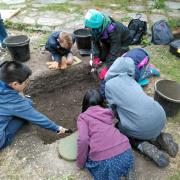Albury Park geophysical survey and test pitting 2023
The original medieval settlement and manor of Albury, in Albury Park, is well-known for its displacement by the local lord(s) of the manor in the late 18th and early 19th century and re-location a kilometre away, to the present-day village, formerly the manor of Weston. Little is known of its earlier history, including its precise extent and any evidence of medieval activity beyond its Domesday ‘Old Saxon’ church (TQ 0631 4785) and mill along the banks of the Tillingbourne.





